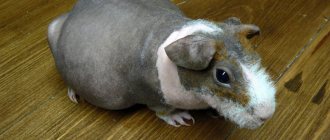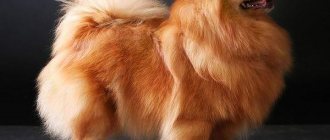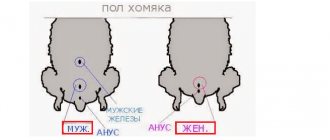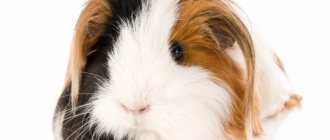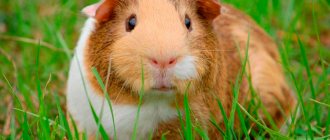- home
- Guinea pig
- Guinea pig breeding
02/07/2019 Breeding guinea pigs is becoming increasingly popular among animal owners. To obtain healthy offspring from pets, the breeder must know the physiological characteristics of rodents, be able to properly breed guinea pigs and create comfortable conditions for the breeding of pets. Babies can be sold to new owners at the age of 1–2 months.
Is it necessary to divorce?
It is important to approach the business of breeding animals with all responsibility - this task is more difficult than it seems. Before taking such a step, you need to carefully consider all the pros and cons and assess your readiness.
Points to consider:
- Pregnancy, childbirth and raising babies negatively affect the health of the mother pig, which means she needs special care and special nutrition;
- frequent or early births shorten the pet’s life;
- future parents need careful selection;
- you need to find a good veterinarian in advance, in case your pet needs medical assistance during delivery (not all doctors do caesarean sections, so you need to immediately clarify the qualifications of the veterinarian you find);
- complications during childbirth can destroy not only the litter, but also the mother (especially in the absence or untimely assistance of a veterinarian);
- toxicosis is fatal for both the cubs and the mother;
- the more numerous the offspring, the more difficult it is to place them (if the fate of the pet’s cubs is important to the owner, it should be taken into account that many purchase small rodents to feed their predatory pets).
If you decide to breed guinea pigs at home, you should read literature on this topic or at least talk to experienced breeders and consult with them on questions of interest.
Complications after childbirth
When the guinea pig gives birth, the breeder will not find the cage cluttered. There will be no blood stains on the cage filler (hay or straw), the children will be dry, quickly and curiously exploring the cage.
READ Tuberculosis in cats and kittens
Why is that? The birth of a child is not a reason for a guinea pig to abandon basic self-defense, and traces of blood and foreign odors can attract predators. Therefore, females are especially sensitive to cleaning the cage and licking their pets. They sometimes overdo it with the latter and accidentally damage the ears of children.
Fatigue after childbirth is the norm not only for guinea pigs, but also for almost every mammal - this process is too complex and exhausting. You should only worry if a long time has passed since the birth (about 6 hours), and the female is still in a bad mood.
There is no need to panic when a woman in labor suffers from slight bleeding during the first days. But a long-term continuation of such a “side effect” (on the third or fourth day after the babies appear) is a reason to contact a veterinarian.
In addition, postpartum complications include:
- Mastitis.
Mastitis is a rather unpleasant infection. In this case, the guinea pig's mammary glands turn red, swell and harden. The animal's temperature will rise and its appetite will decrease.
How to help your pet? Express milk. This is done with clean hands. After which a small massage of the mammary glands is performed.
- Baldness.
Childbirth and lactation change the rhythm of life of a guinea pig. Changes in hormonal levels can lead to baldness of your pet. Hair loss may be accompanied by the appearance of cracks and wounds on the skin.
How can you help in such an unpleasant situation? It’s quite simple - bald areas need to be lubricated with a disinfectant solution and a softening (for example, baby) cream.
How do guinea pigs reproduce?
Breeders are recommended to breed pets in the spring season. Comfortable home keeping allows animals to mate all year round. But the healthiest and most suitable for subsequent procreation are considered to be babies born in the summer from large-sized dairy pigs.
One pig is able to impregnate several pigs. This feature can be used for large-scale polygamous breeding, when one pig and 10 pigs live side by side in one dwelling.
Beginning breeders are recommended to form classic pairs - one father, one mother. If the animals like each other, they will create a full-fledged family in which the spouses tenderly and attentively take care of each other and mutually love their partner until their last breath.
Mating of guinea pigs is determined not only by the proximity of opposite-sex individuals in the same dwelling, but also by mutual sympathy. Sometimes animals do not allow a representative of the opposite sex to approach them even during the mating season - the animals simply did not like each other. Romantic feelings will no longer arise in such a couple - there will only be quarrels and fights. The selected partner needs to be replaced.
Reproduction of guinea pigs depends not only on the preferences of the pets. For the process to be successful, mutual sympathy must be complemented by certain conditions of detention. Partners should eat a healthy and balanced diet. The cage with the pair should be located in a room with optimal air humidity and a temperature no higher than +20 °C.
Newborn care
Newborn babies should not be picked up. As the common people would say, this will give them a “human smell”, because of which the female may refuse feeding and care.
The cage should be in a quiet and peaceful place. Even before giving birth, she needs to be well prepared - provide soft bedding, availability of drinking bowls and bowls of food. Regular cleaning and water changes should be carried out.
The female will feed her babies for about twenty days, and after that they will get stronger and be ready for life in a separate cage/container. The most beautiful ones can be selected for further reproduction. Of course, they can be crossed with each other, but there is a high risk that such selection will lead to the appearance of immune-weak individuals (the usual rules of genetics). Therefore, as a couple, it is better to get an animal from a different kind.
Selection by breed
The number of animal breeds and different variations of their colors cannot be counted. Sometimes new species appear by chance. But it is unlikely that it will be possible to breed a new variety at home - this requires obtaining at least ten animals with securely fixed characteristic features of the new breed.
Experienced breeders breed predominantly purebred animals, that is, from generation to generation, crossing representatives of the same breed, and not allowing the inclusion of other varieties.
Crossing pets with long and short hair is not encouraged - such a union will produce mixed-breed babies. Their appearance will be interesting, but such animals will not be able to participate in exhibitions or continue the family line.
To breed breeding pets, it is prohibited to bring together motley animals. Such offspring only slows down the development of the breed. Therefore, when choosing a partner for your pet, you should consider only animals of either the same breed or varieties that are acceptable for crossing.
Pair selection
The success of pig breeding largely depends on the correct formation of a pair of animals. Determining the right breeds is half the battle. It is equally important to choose the right specific partner.
Pigs forming a pair must be approximately the same age and not closely related. Among the mandatory requirements for future parents are also:
- good character;
- healthy body;
- fatness;
- good physical condition;
- absence of hereditary diseases.
For example, for mating you cannot take an animal that has ever had problems with teeth - the offspring will inherit bad teeth.
Particular attention should be paid to the color of the animals. Rodents of some colors cannot be crossed with each other - these are roan-colored animals, as well as Dalmatians. When crossing dark guinea pigs with each other, a lethal gene is formed - the offspring will not be viable. Even if some babies manage to survive, they will receive abnormalities that will make their existence a real torment - blindness, deafness, deformation of body parts or internal organs, etc.
As for diseases that are not inherited, the animal should not participate in mating until the disease is completely cured. You should also not mate your pet immediately after healing. From the moment the animal fully recovers, you need to wait some time and only after that bring it together with a partner.
In order for healthy babies to be born, future parents should not be skinny or, on the contrary, overfed. The best weight is considered to be 700–1000 g for both mother and father (the minimum acceptable is 500 g).
Pets that are too slender may have problems with pregnancy and delivery, which can lead to the death of both the babies and the mother herself. Well-fed animals may have difficulties with fertilization and also childbirth. Overly plump animals are recommended to be put on a diet and to increase the amount of activity and walks. When the pet loses excess weight, it can be allowed to mate.
Baby care
After the guinea pig has given birth, there is nothing special for a person to do, since the mother herself is capable of caring for the offspring. Usually 1 to 5 cubs are born. Their weight is about 50-100 g (it all depends on the size of the litter), they are covered with hairs, have teeth, their eyes are open and in just a few minutes they can move independently.
The female has only two nipples, but they are quite enough to feed all the offspring - the newborns suckle in turns. From the third day, babies begin to try food for adult animals.
If for some reason the pig refuses to feed the babies or she does not have milk, the cubs are transferred to artificial feeding or placed with another mother. Before this, the piglet’s fur is wiped with sawdust taken from the stepmother’s cage so that the latter can better accept the foundling.
You can also raise offspring using artificial feeding. To do this, newborns are administered 1 cc using a pipette. see baby formula every two hours for a week. They are also given hay and green food.
Do not forget to stimulate defecation and urination in orphans using a cotton pad, which is used to irritate the anal area.
Estrus in guinea pigs
A sign of sexual maturity and readiness for reproduction is the onset of estrus - outside of this process, mating is impossible. Estrus in guinea pigs occurs every 13–20 days after reaching sexual maturity and lasts 24–48 hours. With the onset of heat, the behavior of the animal changes. She becomes flirtatious, flirts with her partner (if she likes him), tries to attract his attention and shows off her butt. The genital organs of guinea pigs that are ready to reproduce become enlarged.
The best period for mating is the first 12 hours from the start of estrus. The pig is placed in a cage with a partner. Guinea pigs mate several times for several seconds. After this, the animals are seated again. If the next heat does not occur, the pig is pregnant. The babies are due in about 10 weeks.
Approaching birth
Finding out that labor is approaching is quite easy. Right before giving birth, the guinea pig behaves lethargically and is constantly sleepy. Sometimes the pet stops appearing in public view altogether, devoting most of its time to arranging a house for future babies.
Your pet's appetite may completely decrease. There is no need to try to force feed the pig. The animal needs absolute peace before an important event.
How do you know when your guinea pig is giving birth? Breeders determine the approach of labor by the disappearance of the membrane that closes the vagina during pregnancy. For an amateur or a beginner in such animal husbandry, news of an imminent addition to the animal family can be a large number of litters - before giving birth, females empty their intestines.
Having noticed the imminent birth of guinea pigs, the owner must take care of the expectant mother. During this period, guinea pigs experience extreme thirst. It would be a good idea to install several drinkers in the cage at once and fill them with tomato juice or juice (decoction) of rose hips.
READ Sarcoptic mange (scabies) in cats
Guinea pig age for mating
Puberty in female pigs occurs earlier than in male pigs. If the latter complete puberty at 12 weeks of age, then in girls it is already at 6–8 weeks. Early maturation is also observed - 5–7 weeks for boy pigs and 3–4 weeks for girls.
Regardless of whether the maturation was normal or premature, the owner must control when guinea pigs begin to mate. 3 weeks after the babies appear, they need to be separated from their mother, divided into two groups by gender. Reproduction should not be allowed soon after the onset of maturity. The offspring of parents who are too young are characterized by weakness - the babies simply will not survive. In addition, there is a high risk of death for the young mother.
For a successful first birth, the appearance of healthy offspring and maintaining the health of the mother, when mating, the pig must be at least 4–6 months of age, but not older than one year. One-year-old animals often experience difficulties during childbirth. However, mating for up to a year is an optional stage in the life of a pet. The little animal will live a full, happy life without motherhood.
The best age for the first mating is 10 months for female pigs and 1 year for male pigs. The optimal number of births for an animal is 2 times a year. More frequent pregnancy will exhaust your pet. It is also not recommended to breed male pigs too often, otherwise they may lose their ability to fertilize.
Pregnancy
So, the long-awaited pregnancy of your guinea pig has arrived! We will now find out everything about this unusual time in the life of every female!
It is not easy to recognize a pregnant guinea pig externally in the early stages. The main sign in this case may be the absence of another heat cycle. If, of course, you carefully monitor your pet’s reproductive cycle. From about 3-4 weeks, the presence of embryos can be determined by very careful palpation.
To do this, place the guinea pig on the table and carefully place your fingers under its belly, with your thumbs resting on the spine. To the touch, the fruits will resemble small peas with liquid inside. They usually lie in a row on opposite sides of the female's abdomen. Experienced breeders can thus easily identify pregnant females and determine how many babies they are expecting. However, if you are still new to this matter, be extremely careful and do not put pressure on the expectant mother’s belly!
Starting from 4-5 weeks, the guinea pig rapidly gains weight and its pregnancy becomes obvious. You can weigh the female weekly and record her weight, this will help predict the number of litters. From about 7 weeks, fetal movements can be observed. Some breeders claim that from 7-8 weeks you can hear little piglets chewing in the womb!
At 8-10 weeks, the dimensions of the pregnant female are already very respectable. The offspring can reach 50% of the weight of the pig itself, and therefore sometimes the expectant mother has difficulty walking at the end of her term. In total, a guinea pig's pregnancy lasts about 10 weeks or 67-72 days. The larger the offspring, the more the term tends to the lower limit.
READ My simple saltwater aquarium • Aquarist's blog
